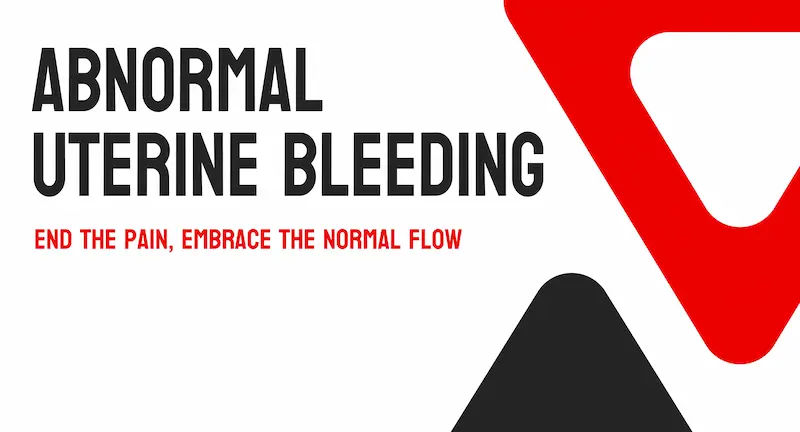Abnormal Uterine Bleeding: Your Guide to Causes, Symptoms, and Care
Know about the abnormal uterine bleeding, what it is, causes, signs, symptoms, causes, diagnosis, and treatment.ment options and how to live with it, and more.

Written by Dr. J T Hema Pratima
Reviewed by Dr. Dhankecha Mayank Dineshbhai MBBS
Last updated on 6th Oct, 2025

Introduction
Every woman's menstrual cycle is unique, but when your period starts to deviate significantly from its normal pattern, it can be a source of worry and disruption. This experience is often referred to as abnormal uterine bleeding (AUB), a broad term that covers any unusual bleeding from the uterus. It's more than just a "heavy period"; it encompasses bleeding that is too heavy, too long, too frequent, or occurs at unexpected times, like between periods or after menopause. Understanding what constitutes AUB is the first step toward addressing it. This guide will demystify abnormal uterine bleeding, walking you through its common signs, potential causes from hormonal imbalances to structural issues like fibroids, and the various diagnostic and treatment paths available.
Recognising the Signs: Symptoms of Abnormal Uterine Bleeding
AUB isn't a one-size-fits-all condition. Its symptoms can vary widely, but they all point to a disruption in your body's normal menstrual rhythm. Paying attention to these changes is crucial.
Changes in Your Menstrual Flow
The most common complaint related to abnormal uterine bleeding is a change in flow volume, often termed heavy menstrual bleeding or menorrhagia. This isn't about simply having a heavier day than usual. Key indicators include:
Soaking through one or more sanitary pads or tampons every hour for several consecutive hours.
Needing to use double protection (e.g., a pad and a tampon) to control the flow.
Waking up multiple times during the night to change protection.
Passing large blood clots (the size of a quarter or larger).
Bleeding that lasts for more than seven days.
Health topic carousel:
Doctor speciality: Gynaecologist
Text: Consult a Gynaecologist for Personalised Advice
Changes in Your Menstrual Cycle Timing
AUB also involves irregularities in the timing of your cycle. This can be just as disruptive as heavy flow. Be mindful of:
Bleeding between periods: Any spotting or bleeding that occurs outside your regular menstrual window.
Frequent periods: Having a cycle shorter than 21 days (polymenorrhea).
Infrequent periods: Having a cycle longer than 35 days (oligomenorrhea).
Postmenopausal bleeding: Any bleeding that occurs after you have reached menopause (12 consecutive months without a period).
If you experience any of these symptoms, especially if they are new or worsening, it's important to take note. If symptoms like heavy bleeding or spotting between periods persist beyond two cycles, consult a doctor online with Apollo24|7 for further evaluation.
Uncovering the Causes: Why Does Abnormal Uterine Bleeding Happen?
The causes of AUB are diverse, which is why a proper diagnosis is essential. Healthcare professionals often use the PALM-COEIN system to categorise causes, which we can simplify into two main groups: structural and non-structural.
Structural Causes (The PALM Group)
These causes involve a physical issue within the uterus.
Uterine Fibroids and Polyps
Fibroids are non-cancerous growths of the muscle tissue of the uterus. They are very common and can cause heavy or prolonged bleeding, especially if they are located within the uterine cavity.
Polyps are typically benign, grape-like growths on the lining of the uterus (endometrium). They can cause bleeding between periods or after intercourse.
Adenomyosis
This condition occurs when the tissue that normally lines the uterus (endometrium) grows into the muscular wall of the uterus. This can cause the uterus to become enlarged and lead to severe pain and heavy bleeding.
Non-Structural Causes (The COEIN Group)
These causes are related to function rather than physical shape.
Coagulation Disorders and Ovulatory Dysfunction
Coagulation Disorders: Conditions like Von Willebrand disease, which affect the blood's ability to clot, can be a root cause of heavy menstrual bleeding.
Ovulatory Dysfunction: This is a common cause, particularly in adolescents and women approaching menopause. If ovulation doesn't occur regularly (as in PCOS, thyroid issues, or extreme stress), the hormonal balance is disrupted, leading to unpredictable bleeding.
Endometrial, Iatrogenic, and Not Yet Classified Causes
Endometrial Issues: This includes endometrial hyperplasia, a thickening of the uterine lining that can sometimes be a precursor to cancer.
Iatrogenic Causes: These are treatment-related. Certain medications (like blood thinners or some antidepressants), or the copper IUD can cause AUB.
Not Yet Classified: This category includes conditions like chronic illnesses that haven't been definitively linked but may contribute.
Getting a Diagnosis: How is Abnormal Uterine Bleeding Evaluated?
Diagnosing AUB is a process of elimination. Your doctor will work with you to pinpoint the exact cause.
The Initial Consultation: What to Expect
Your doctor will start with a detailed medical history and a physical exam, including a pelvic exam. Be prepared to discuss:
Your menstrual cycle patterns (start date, flow, symptoms).
Your personal and family medical history.
Any medications or supplements you are taking.
Your lifestyle and stress levels.
Common Diagnostic Tests
Based on the consultation, your doctor may recommend one or more tests:
Blood Tests: To check for anaemia, thyroid function, and hormone levels, and to rule out bleeding disorders. Apollo24|7 offers convenient home collection for tests like thyroid panels or complete blood count (CBC) to check for anaemia.
Pap Smear: To screen for cervical cancer, which can sometimes cause bleeding.
Pelvic Ultrasound: This imaging test is crucial for looking for structural causes like fibroids, polyps, or adenomyosis.
Endometrial Biopsy: A small sample of the uterine lining is taken to check for abnormalities, especially important for women over 45.
Hysteroscopy: A thin, lighted scope is inserted through the cervix to view the inside of the uterus directly.
Health topic carousel:
Lab test: Globulin Blood Tests, Pelvic Ultrasound, Hysteroscopy and Endometrial Biopsy
Text: Get Your Symptoms Assessed
Finding the Right Path: Treatment Options for Abnormal Uterine Bleeding
Treatment is highly individualised and depends entirely on the underlying cause, your age, and whether you wish to have children in the future.
Medications to Regulate Bleeding
Often, the first line of treatment involves medication:
Hormonal Birth Control: Pills, patches, vaginal rings, or hormonal IUDs can regulate cycles and significantly reduce bleeding.
Tranexamic Acid: A non-hormonal medication that helps blood clot and reduces heavy flow.
Nonsteroidal Anti-inflammatory Drugs (NSAIDs): Like ibuprofen, which can reduce blood loss and relieve cramping.
Gonadotropin-releasing hormone (GnRH) agonists: These can temporarily induce a menopausal state to shrink fibroids and control bleeding, often used as a short-term solution before surgery.
Surgical Procedures and Interventions
If medications are ineffective or if a structural issue is identified, surgery may be recommended:
Hysteroscopy: Used not just for diagnosis but also to remove polyps or fibroids.
Endometrial Ablation: A procedure that destroys the uterine lining to reduce or stop bleeding permanently (not for women who want future pregnancies).
Uterine Artery Embolisation: A minimally invasive procedure that cuts off the blood supply to fibroids, causing them to shrink.
Hysterectomy: The surgical removal of the uterus. This is a definitive solution for bleeding, but is only considered when other treatments have failed or are not desired.
Living with Abnormal Uterine Bleeding: Management and Self-Care
While medical treatment addresses the root cause, managing day-to-day life with AUB is important for your well-being.
Track Your Cycle: Use a journal or an app to log your flow, symptoms, and any episodes of spotting. This information is invaluable for your doctor.
Manage Iron Deficiency: Heavy bleeding can lead to anaemia. Eat iron-rich foods (leafy greens, red meat, lentils) and consider a supplement after consulting your doctor.
Manage Pain: Use a heating pad and over-the-counter pain relievers for cramps.
Prioritise Self-Care: The fatigue and stress of AUB are real. Ensure you get enough rest and engage in stress-reducing activities like gentle yoga or walking.
Conclusion
Experiencing abnormal uterine bleeding can be isolating and stressful, but it's important to remember that it is a common and treatable condition. By understanding the symptoms and potential causes, you are already taking a powerful step toward better health. This guide serves as a starting point for a conversation with your healthcare provider. Your menstrual health is a vital sign of your overall well-being. Don't dismiss persistent changes or assume severe discomfort is normal. If your condition does not improve after trying initial management methods, book a physical visit to a doctor with Apollo24|7 to get the personalised care and effective treatment you deserve. Taking action is the first step toward regaining control and living your life without interruption.
Health topic carousel:
Doctor speciality: Gynaecologist
Text: Consult a Gynaecologist for Personalised Advice
Frequently Asked Questions
1. What is the difference between a heavy period and abnormal uterine bleeding?
A.A heavy period is subjective, but AUB is clinically significant. Key differentiators are bleeding that soaks through a pad/tampon every hour for several hours, lasts more than 7 days, or includes passing large clots. If your flow disrupts your daily life, it's likely AUB.
2. Can stress cause abnormal uterine bleeding?
A.Yes, high levels of physical or emotional stress can disrupt your hypothalamic-pituitary-ovarian axis, leading to ovulatory dysfunction. This can cause missed periods, irregular spotting, or unusually heavy bleeding.
3. When should I go to the ER for heavy menstrual bleeding?
A.Seek immediate emergency care if you experience dizziness, lightheadedness, fainting, signs of shock (cold, clammy skin, rapid pulse), or if you are soaking through more than one pad per hour for two consecutive hours.
4. What are the treatment options for heavy bleeding caused by fibroids?
A.Options range from hormonal medications (like the IUD or pills) to minimally invasive procedures like uterine artery embolisation or hysteroscopic myomectomy (fibroid removal). In severe cases, a hysterectomy may be considered.
5. Is abnormal bleeding always a sign of cancer?
A.No, the vast majority of AUB cases are caused by benign (non-cancerous) conditions like hormonal fluctuations, fibroids, or polyps. However, because endometrial cancer can present as bleeding, especially after menopause, it's crucial to see a doctor for a proper evaluation to rule out serious causes.
Consult Top Specialists for Personalised Tips

Dr. Mona Yadav
Obstetrician and Gynaecologist
19 Years • MBBS, MD (Obstetrics & Gynaecology)
Dombivli
Nulife multispeciality, Dombivli

Dr. Ramya G S
Obstetrician and Gynaecologist
11 Years • MBBS, DGO - Obstetrics & Gynaecology, DNB - Obstetrics & Gynaecology
Bengaluru
Apollo Clinic, JP nagar, Bengaluru

Dr. Soumya P
Obstetrician and Gynaecologist
6 Years • MBBS,MS (OBST & GYNAE)
Bengaluru
Apollo Clinic, JP nagar, Bengaluru

Dr. Damayanti Pentiyala
Obstetrician and Gynaecologist
27 Years • MBBS, MD
Khammam
Kinnera Hospital, Khammam
(250+ Patients)
Dr. K Anusha
Obstetrician and Gynaecologist
4 Years • MBBS, DGO
Yemmiganur
SRINIVASAA HOSPITAL, Yemmiganur
Consult Top Gynaecologist

Dr. Mona Yadav
Obstetrician and Gynaecologist
19 Years • MBBS, MD (Obstetrics & Gynaecology)
Dombivli
Nulife multispeciality, Dombivli

Dr. Ramya G S
Obstetrician and Gynaecologist
11 Years • MBBS, DGO - Obstetrics & Gynaecology, DNB - Obstetrics & Gynaecology
Bengaluru
Apollo Clinic, JP nagar, Bengaluru

Dr. Soumya P
Obstetrician and Gynaecologist
6 Years • MBBS,MS (OBST & GYNAE)
Bengaluru
Apollo Clinic, JP nagar, Bengaluru

Dr. Damayanti Pentiyala
Obstetrician and Gynaecologist
27 Years • MBBS, MD
Khammam
Kinnera Hospital, Khammam
(250+ Patients)
Dr. K Anusha
Obstetrician and Gynaecologist
4 Years • MBBS, DGO
Yemmiganur
SRINIVASAA HOSPITAL, Yemmiganur
.webp)
